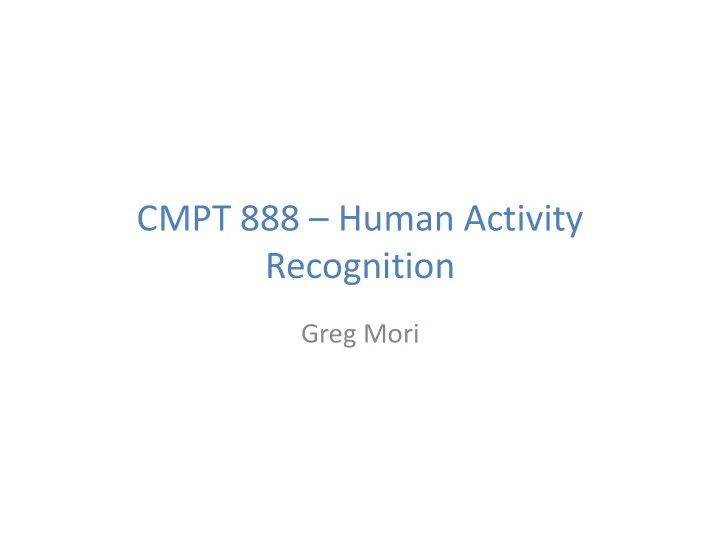

CMPT 888 – Human Activity Recognition Greg Mori
Outline • Intro to class • Administrative details
Overview • This class is about vision‐based action recognition – Input is images or videos – Output is description of what people are doing in the images/videos
Action Recognition Example • Recognize human actions from raw video data
Gathering action data • 3 components: – detect humans, track, recognize action
Applications I • Automated video surveillance – Draw attention to actions of interest – Save human operator time 6
Applications II • Collect data on pedestrian behaviour – Collaboration with Saunier and Sayed (UBC Civil Engineering)
Applications III Automatically detect falls, near‐falls (with S. Robinovitch SFU)
Why use Computer Vision? • Competing approaches – Wearable sensors – Manual labour • Non‐intrusive – Do not need cooperative subjects • Inexpensive, no operator fatigue – Semi‐automatic techniques
PROBLEM DEFINITION
What is Action Recognition? • Terminology – What is an “action”? • Output representation – What do we want to say about an image/video? Unfortunately, neither question has satisfactory answer yet
Terminology • The terms “action recognition”, “activity recognition”, “event recognition”, are used inconsistently – Finding a common language for describing videos is an open problem
Terminology Example • “Action” is a low‐level primitive with semantic meaning – E.g. walking, pointing, placing an object • “Activity” is a higher‐level combination with some temporal relations – E.g. taking money out from ATM, waiting for a bus • “Event” is a combination of activities, often involving multiple individuals – E.g. a soccer game, a traffic accident • This is contentious – No standard, rigorous definition exists
Output Representation • Given this image what is the desired output? • This image contains a man walking – Action classification / recognition • The man walking is here – Action detection
Output Representation • Given this image what is the desired output? • This image contains 5 men walking, 4 jogging, 2 running • The 5 men walking are here • This is a soccer game
Output Representation • Given this video what is the desired output? • Frames 1‐20 the man ran to the left, then frames 21‐25 he ran away from the camera • Is this an accurate description? • Are labels and video frames in 1‐1 correspondence?
Challenges in Recognition • Intra‐class variation • Object pose variation • Background clutter • Occlusion • Lighting
TRIMESTER PREVIEW
Week 2 • Preliminaries – Human detection – Background subtraction – Optical flow Dalal + Triggs CVPR05
Weeks 3‐4 • Motion Templates Bobick and Davis PAMI01 Efros et al. ICCV03
Weeks 5‐6 • Local feature video representations Dollar et al. VSPETS05 Schuldt et al. ICPR04
Week 7 • Unsupervised and weakly supervised methods Laptev et al. CVPR08
Week 8 • Temporal models ? ? ? ? ? ? ? ? ? ? Wang and Mori PAMI09
Week 9 • Human pose estimation and pose retrieval Yang et al. CVPR10
Week 10 • Discriminative methods Run right Walk left Run right 45 Fathi and Mori CVPR08
Week 11 • Human actions in still images SLAG Wang et al. CVPR06
ADMINISTRIVIA
Course Plan • Read research papers – For each topic I present important papers – Students each present a recent paper – We discuss • Do a project – Gain in‐depth experience on a problem and algorithm
Introductions
Prerequisite • No formal prerequisites – But it would be best if you know some computer vision / image processing and some machine learning • You will need to do the usual things – Math (continuous), programming, reading, writing, presenting • Ask me if you are concerned
Grading Scheme • 10% Class participation – Participate in discussions about papers, ask/answer questions • 10% Reading assignments – 1 or 2 papers each week; subset of the ones I present • 10% Paper presentation – Choose from list of papers online • 10% Assignment – Small programming assignment on motion analysis • 60% Project – Individual or in small groups – Presentation, written report
Reading Assignments • Similar to mini paper review – One paragraph summarizing paper – Critical discussion (what you like / don’t like) – Questions you have (for me to explain) • Due before start of lecture via email – First one due Monday • These details and list of papers are online
Paper Presentations • Choose one paper that interests you – From list online / in syllabus • 20 minute presentation – 10+ minutes questions/discussion – Feel free to use slides provided by authors
Assignment • Short programming assignment – Background subtraction – Motion‐based action recognition • Out next week, due 2 weeks later
Project • Major component of course – Recognize actions • Implement existing technique – Or variant thereof – Can use something you’re working on in your research • Must recognize actions • Must do something that didn’t exist before this course • Proposal, presentation, report
Course Plan • Next week – Preliminaries • Background subtraction, human detection, motion • After that – Papers, papers, papers
Recommend
More recommend